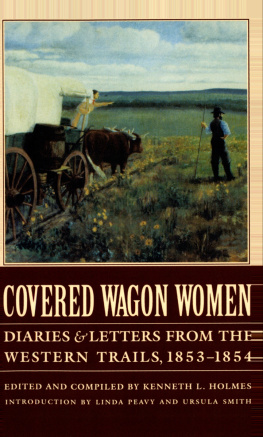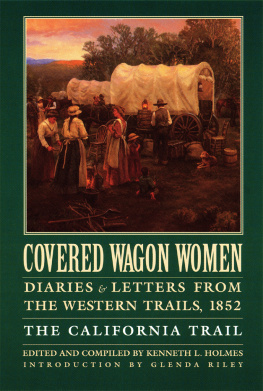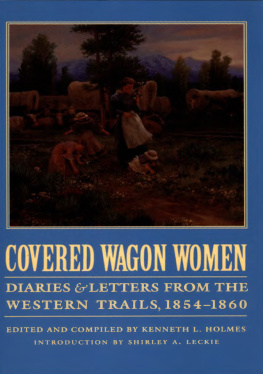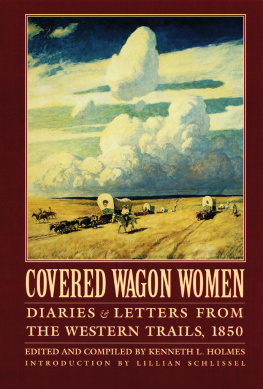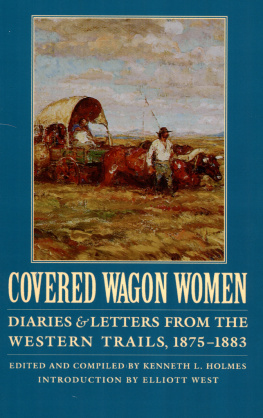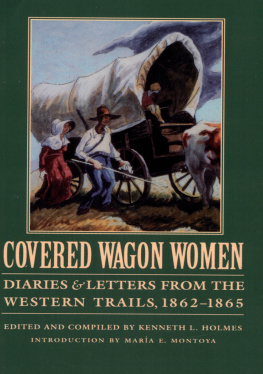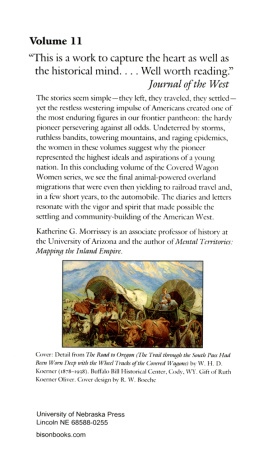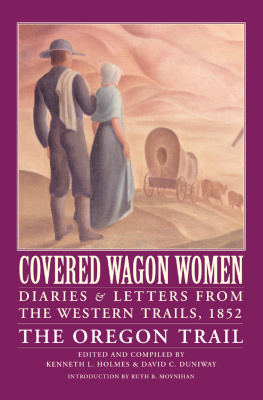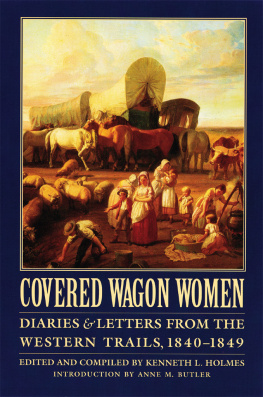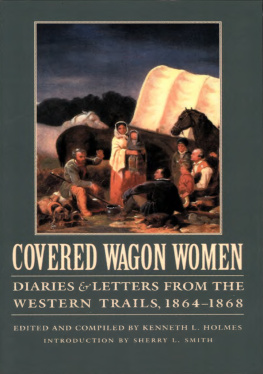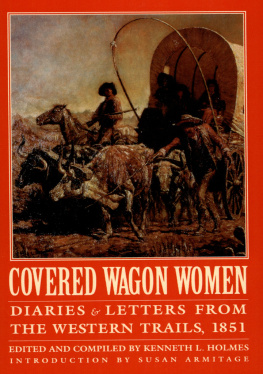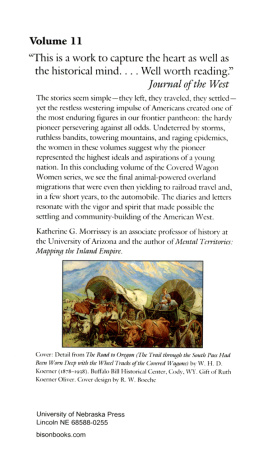Kenneth L. Holmes - Covered Wagon Women: Diaries & Letters from the Western Trails. 1854-1860
Here you can read online Kenneth L. Holmes - Covered Wagon Women: Diaries & Letters from the Western Trails. 1854-1860 full text of the book (entire story) in english for free. Download pdf and epub, get meaning, cover and reviews about this ebook. genre: Home and family. Description of the work, (preface) as well as reviews are available. Best literature library LitArk.com created for fans of good reading and offers a wide selection of genres:
Romance novel
Science fiction
Adventure
Detective
Science
History
Home and family
Prose
Art
Politics
Computer
Non-fiction
Religion
Business
Children
Humor
Choose a favorite category and find really read worthwhile books. Enjoy immersion in the world of imagination, feel the emotions of the characters or learn something new for yourself, make an fascinating discovery.
- Book:Covered Wagon Women: Diaries & Letters from the Western Trails. 1854-1860
- Author:
- Genre:
- Rating:4 / 5
- Favourites:Add to favourites
- Your mark:
- 80
- 1
- 2
- 3
- 4
- 5
Covered Wagon Women: Diaries & Letters from the Western Trails. 1854-1860: summary, description and annotation
We offer to read an annotation, description, summary or preface (depends on what the author of the book "Covered Wagon Women: Diaries & Letters from the Western Trails. 1854-1860" wrote himself). If you haven't found the necessary information about the book — write in the comments, we will try to find it.
Covered Wagon Women: Diaries & Letters from the Western Trails. 1854-1860 — read online for free the complete book (whole text) full work
Below is the text of the book, divided by pages. System saving the place of the last page read, allows you to conveniently read the book "Covered Wagon Women: Diaries & Letters from the Western Trails. 1854-1860" online for free, without having to search again every time where you left off. Put a bookmark, and you can go to the page where you finished reading at any time.
Font size:
Interval:
Bookmark:

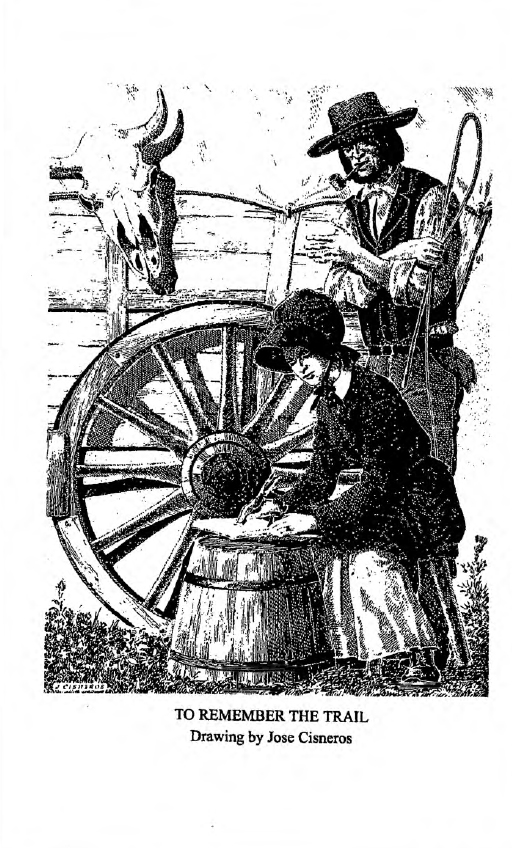

The publisher does not have any control over and does not assume any responsibility for author or third-party websites or their content
1986 by Kenneth L. Holmes. Reprinted by arrangement with the Arthur H. Clark Company.
Introduction to the Bison Books Edition 1998 by the University of Nebraska Press All rights reserved
The paper in this book meets the minimum requirements of American National Standard for Information SciencesPermanence of Paper for Printed Library Materials, ANSI Z39.481984.
First Bison Books printing: 1998
Library of Congress Cataloging-in-Publication Data
The Library of Congress has cataloged Vol. 1 as:
Covered wagon women: diaries & letters from the western trails, 18401849 / edited and compiled by Kenneth L. Holmes; introduction to the Bison Books edition by Anne M. Butler,
p. cm.
Originally published: Glendale, Calif: A. H. Clark Co., 1983.
Reprinted from volume one of the original eleven-volume edition
T.p. verso.
Volume 1.
Includes index.
ISBN 0-8032-7277-4 (pa: alk. paper)
1. Women pioneersWest (U.S.)Biography. 2. West (U.S.)History. 3. West (U.S.)Biography. 4. Overland journeys to the Pacific. 5. Frontier and pioneer life West (U.S.) I. Holmes, Kenneth L.
F591.C79 1996
978dc20 95-21200 CIP
Volume 2 introduction by Lilian Schlissel.
ISBN 0-8032-7274-X (pa: alk. paper)
Volume 3 introduction by Susan Armitage.
ISBN 0-8032-7287-1 (pa: alk. paper)
Volume 4 introduction by Glenda Riley.
ISBN 0-8032-7291-X (pa: alk. paper)
Volume 5 introduction by RuthB. Moynihan.
ISBN 0-8032-7294-4 (pa: alk. paper)
Volume 6 introduction by Linda Peavy and Ursula Smith.
ISBN 0-8032-7295-2 (pa: alk. paper)
ISBN-13: 978-0-8032-7475-4 (electronic: e-pub)
ISBN-13: 978-0-8032-7476-1 (electronic: e-mobi)
Reprinted from volume six (1986) of the original eleven-volume edition titled Covered Wagon Women: Diaries and Letters from the Western trails, 18401890, published by The Arthur H. Clark Company, Glendale, California. The pagination has not been changed and no material has been omitted in this Bison Books edition.
Introduction to the Bison Books Edition
Linda Peavy and Ursula Smith
Late in 1980, as Kenneth Holmes worked on his proposal for Covered Wagon Women, he noted in a letter to his prospective publisher, Robert Clark, that he thought this could well be another classic set of books, though he still had some sorting out of ideas to do.
Those lines have proven to be prophetic. The eleven-volume series of womens diaries and letters brought out by the Arthur H. Clark Company over the next thirteen years was indeed a classic set of books but one that has required some sorting out of ideas by readers as well as by the editor.
The sorting out continues with this reprint edition of Covered Wagon Women. But the musings of the reader today are informed by the work of the many scholars who, during the fifteen years since the first volume appeared, have given us a basis for looking at the frontier experienceespecially the womans experiencein previously unthought-of ways.
Indeed, it is tempting to assume that the letters and diaries of the ten women represented here will yield definitive answers to some of the major questions raised by recent scholarship. Did migrant women look to the West with fear or with anticipation? What effect did the move have on family dynamics? Were men and women affected differently by the journeys? Did pioneer women gain cultural and economic freedom in the West? What of racial interaction? Was it different for the westering female than for the westering male? And did pioneer women themselves perpetuate the cultural and habitual sexism and racism of the nineteenth century?
However, one would be hard put to find sufficient commonality of experience on which to base the answers to such questions. Consider the highly diverse backgrounds of the women included here. The three Butler sisters, natives of Kentucky, were bom frontierswomen whose family history bespoke the restless American. Boston-born Amelia Knight, the wife of a physician, was pregnant with her eighth child when she crossed the plains. Celinda Hines was an unmarried school-teacher traveling in the company of her parents and her extended family. Sarah Perkins, an Indiana farmwoman with minimal education, had lost several children before she joined her husband on the journey west. Carefree Rachel Taylor turned fifteen during her journey. Forty-five- year-old Hannah King, an upper-class Englishwoman, a Mormon convert, and a published novelist and poet, traveled toward Zion with her husband and four of her children. New York native Mary Burrell celebrated her nineteenth birthday during a crossing made in the company of her family and her fiance. Elizabeth Myrick, a Wisconsin farmwife who had given birth to her first child while her husband sought gold in the West, now joined him in a move to the fertile farmlands of northern California.
Despite such diversity, there are some interesting parallels to be found in the experiences of this panoply of pioneers. For example, to a woman, these diarists are acutely aware of their environment. Even Sally Perkins, whose entries are typically as sparse as the high prairies she crossed, recorded the scenery: roling preraris caught her eye on April 25, 1853, and on August 31, her journey almost complete, she wrote of heavy hills and very stoney. Amelia Knight noted on May 26, 1853, that she went up on a high bluff, and had a splendid view of platte and her beautiful timbered Islands. Celinda Hines was often swept by what she observed: All day the scenery was most enchanting intirely surpassing in loveliness & originality any thing I had ever beheld (June 17, 1853). Equally prone to effusive descriptions was Hannah King, who noted on the edge of the Rockies that it seems something marvellous & mysterious that our Cavalcade should pass along breaking the Eternal Silence of these wild places (August 28, 1853).
The reader is struck not only by each womans eye for detail but also by the varied responses of different women to the same natural phenomena. On July 8, 1853, Amelia Knight visited Steamboat Springs, a great curiosity [that] spouts up about a foot and a half, out of a hole in the solid rock. Seventeen days later, Celinda Hines devoted over three hundred words to the wonders of far famed Soda Springs and Steam-boat spring so called from the noise of its ebullitions. In contrast, after an August 16, 1853, visit to the celebrated Soda and Steamboat Springs area, Rachel Taylor declared that she did not feel paid for [her] trouble in going there. Yet nearly one year later, on July 16, 1854, Elizabeth Myrick was intrigued by Steamboat Springs: it boils furiously all the time.
The reader is struck as well by the abrupt mood swings evident in the daily records of some of the women. On June 26, 1854, Mary Burrell, an exuberant and observant nineteen-year-old, wrote of seeing 12 different kinds of flowers within 1/2 a mile. Yet delight turned quickly to despair. Mother is taken sick, she fretted in that same passage. Oh Dear me! what if we all get sick! Two days later, with her mother on the recovery, her spirits rebounded and she wrote of Many new flowers & very fragrant. On September 15, 1853, on the brink of her long-anticipated entry into Salt Lake City, Hannah King was so beset with worries over her son-in-laws obvious intention to wed two more of her daughters that she wrote of beautiful Bluffsbeautiful Kanyons and of sorrows & troubles & tears! &c &c mixed up with the beauties of nature.
Next pageFont size:
Interval:
Bookmark:
Similar books «Covered Wagon Women: Diaries & Letters from the Western Trails. 1854-1860»
Look at similar books to Covered Wagon Women: Diaries & Letters from the Western Trails. 1854-1860. We have selected literature similar in name and meaning in the hope of providing readers with more options to find new, interesting, not yet read works.
Discussion, reviews of the book Covered Wagon Women: Diaries & Letters from the Western Trails. 1854-1860 and just readers' own opinions. Leave your comments, write what you think about the work, its meaning or the main characters. Specify what exactly you liked and what you didn't like, and why you think so.

